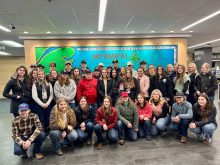A new product developed by engineers in British Columbia is proving itself in pastures and feedlots around the world and is now available from distributors in Canada. PowerFlex posts are made from a new material, orientated wood plastic composite (wpc), which gives them the flexibility to bend and spring back into an upright position when put under pressure.
PowerFlex posts are manufactured in the U. S. exclusively for PowerFlex Fence, which purchased the licence on the innovative manufacturing process in 2005. The parent company, Powerflex Systems Corp., headquartered at Hartville, Missouri, specializes in pasture fencing and watering systems.
Read Also

Growing Canada’s beef herd: CCA’s priorities working with new federal government
This is my first column since the federal election. The Canadian Cattle Association works with all elected officials and parliamentarians, regardless…
PowerFlex Systems founder and president David Krider explains it’s the orientation technology that gives this second-generation wpc product its updated look, feel and function. It is made from approximately 30 per cent wood flour (fibre) and 70 per cent polypropylene. The orientation process elongates the thermoplastic polymers to produce material that has a grain similar to wood, but with no splinters. Oriented wpc is stiffer and stronger than the original wpc materials, however, it has a lower density that allows it to bend without snapping.
Lightweight and rugged, PowerFlex posts are recommended by the company for use as line posts for electric fencing. The real standout feature is the post’s ability to work in unison with hi-tensile wire, which also has characteristics that allow it to stretch and return to its initial tension. When put under pressure, whether it be from livestock crowding, running the fence, wildlife, heavy ice load, snow drifts, and even the weight of tumbleweeds, the post and the wire will give without breaking. Secondly, the posts are self-insulating, so there’s no worry of insulators popping off or snapping apart.
PowerFlex posts are readily available in black, brown and white, or you can special order your colour of choice. The 11/8-inch diameter post comes in 48-inch and 54-inch lengths, while the 11/4-inch diameter post and the 15/8-inch diameter post are available in lengths of 60, 66 and 72 inches.
There are now three distributors in Canada: Rob Davidson at Creston, B. C. (250-402-8664), Stephen Burgess at North Lancaster, Ont. (613-347-7291), and Glenn Keddie at Grand Prairie, Alta. (800-390-6924).
Tips for constructing a PowerFlex post fence
The following recommendations have been compiled based on the experience of Powerflex Systems’ employees and distributors, who have put PowerFlex posts to the test on their own farms and ranches. Many customers who have installed fences in varied geographic regions across the U. S. have also contributed tips and testimonials.
We found Krider and Davidson at the Western Canadian Grazing Conference trade show. Krider, an experienced grazier himself, built his first electric fence system back in the mid-1980s. Davidson is a grazing mentor who specializes in grazing management and sales, design and installation of electric fence systems, livestock handling equipment and solar water systems.
They assure us that PowerFlex posts can take a pounding with any manual or hydraulic post driver. The top end has a heated bevel finish that won’t mushroom out and the bottom end is pointed to bore into the ground.
They recommend using a pilot driver when installing the posts in rocky terrain or into hard, dry ground. You can make one by taking a piece of pipe that fits over the post and capping it off. If you make the driver the same length as the desired height of the post after installation, you’ll know to quit pounding when the driver contacts the ground. The driver works great anytime you install posts to keep them straight and of uniform height. When using a hydraulic driver, the pilot driver will keep the post from flexing under pressure. In extreme conditions, some ranchers have pre-drilled holes into the ground using a rotary hammer drill.
The depth depends upon your soil conditions and intended purpose. The rule of thumb is to use the 11/8-inch posts for single-or double-strand cross-fences. The 11/4-inch posts are the best choice for multi-wire fences, and the 15/8-inch posts















